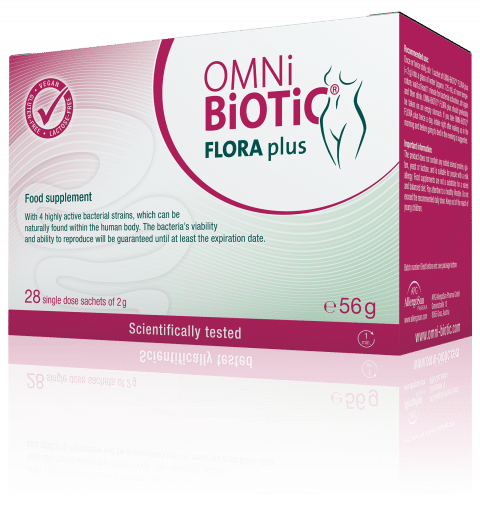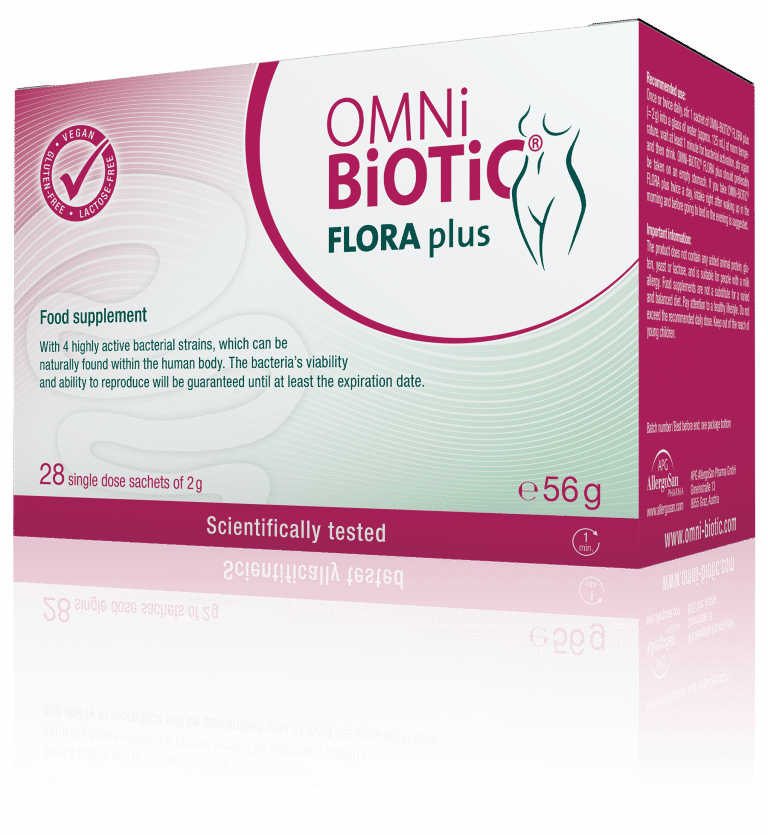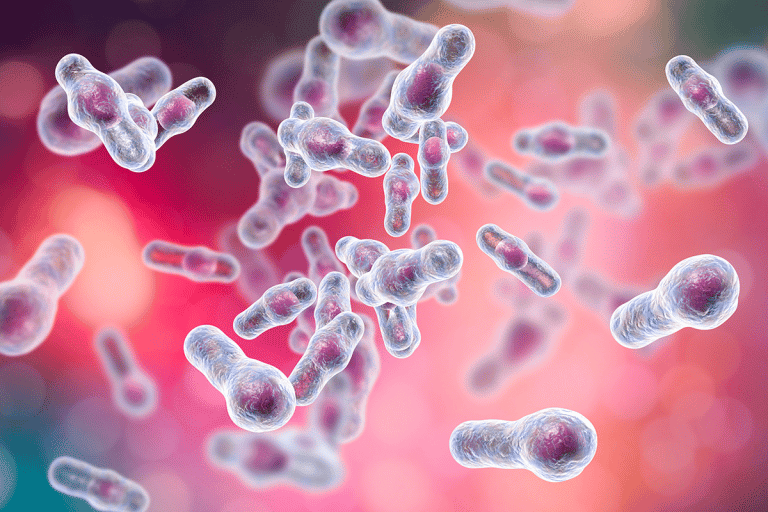
Thore Hansen
Intimate Health: The vaginal flora through the years
Almost every woman suffers from a vaginal infection at least once in her life. It is not uncommon for this – accompanied by corresponding symptoms – to become a recurring or even chronic condition. This means a reduced quality of life, sometimes loss of libido or even infertility. An optimal composition of a healthy vaginal flora is, therefore, a decisive prerequisite for a woman’s quality of life and health. But the all-important vaginal microbiome is always subject to numerous influences and changes in principle from birth to old age.
The healthy vaginal microbiome consists largely of bacteria of the genus Lactobacillus and functions as an important protective shield against infections in the intimate area, for example, bacterial vaginosis (bacterial vaginal infection), thrush or urinary tract infections. The lactobacilli make it difficult for pathogenic germs to settle: the bacteria of the vaginal flora metabolise glycogen, a storage form of carbohydrates, into lactic acid – which is why they are also called lactic acid bacteria. This process is relevant for maintaining an acidic pH of 3.8 to 4.4 in the vagina and creates an environment that prevents the growth of pathogenic germs.
A healthy vagina starts to be built up from birth – with the help of intestinal bacteria.
The fact that the female genital area in particular is so frequently attacked by fungi and harmful bacteria is also related to the female anatomy: Because the female sexual organ is the only human organ that has a direct connection from the outside to the inside. While our intestines are protected by the sphincter, and the ear and lungs are a dead end, the vagina, on the other hand, is open deep into the body. “This requires special protective functions. The vaginal skin is protected by three different layers: using defence by lactic acid bacteria on the surface, the tissue itself and the immune system behind the surface. The microbiome and the immune system work closely together in this process,” explains the Leipzig gynaecologist Dr Tarané Probst. So what is already known and proven about the intestine also applies to the vagina.
 Protective shield from birth onwards
Protective shield from birth onwards
A healthy vaginal flora is already established from birth – with the help of healthy gut bacteria. If you look at the female pelvis in cross-section, you will see that the anal area or rectum, vaginal area and urinary tract are not “dense”, closed systems, but open out into orifices. Between the anal and vaginal areas, there is a “mucus pathway”: Via this physiological transport pathway, lactobacilli are permanently transported from the rectum, which serves as a reservoir for useful lactic acid bacteria, forward into the vagina. This close connection between the intestinal and vaginal flora explains why factors that disturb the intestinal flora also have a negative influence on the vaginal flora – and why a healthy vaginal flora is particularly sustainably supported by the oral intake of probiotics, e.g. by drinking.
Caesarean section – unfavourable start for the microbiome?
How the child’s intestinal flora and subsequently the vaginal flora and immune system develop depends, among other things, on birth. If children are not born naturally and do not pass through the birth canal, they are not or not sufficiently exposed to the vaginal microbiome. Of course, a caesarean section may be necessary to protect the health of the mother and give the child a safe start in life – there is no question that this birth route saves many lives. However, there is also a strong trend towards elective caesarean sections, where natural birth is not considered from the outset: In Germany, about 30 % of children are born by caesarean section.
“Apart from the physiological stress for the mother caused by a wound, by stress during the operation and the anaesthesia, there is hardly any transmission of the so important bacteria during a caesarean section. This can also be proven, for example, by finding more skin germs in the intestines of children born via caesarean section. The lack of certain germs, which are supposed to make our immune system tolerant to certain bacteria, then causes an overreaction of the immune system, which leads to skin diseases like neurodermatitis and allergies. If the mother – as is usual in the case of a caesarean – is prescribed antibiotics, an altered microbiome is also passed on via the mother’s milk,” explains Probst.
How does hormonal development change the vaginal mucosa?
 With the onset of puberty and thus fertile age, the vaginal mucosa builds up several layers of cells and thus becomes thicker and stronger. Nature thinks along with us: Since women have more sexual intercourse in the first half of life and need stronger protection in this phase than before sexual maturity, the mucous membranes strengthen. And the lactic acid bacteria are also stimulated to increase their activity to strengthen the protective shield: “Due to the influence of oestrogen, more glycogen is stored during puberty, which in turn is beneficial for the production of lactic acid. However, when a woman has a reduced oestrogen level – for example during menopause – she stores less glycogen. As a result, fewer good bacteria remain in the vagina. This can be seen in patients who have a gynaecological tumour and are receiving anti-hormone therapy. Because of the low hormone levels, the skin and mucous membranes in the body change. They become thinner, as does the vaginal mucosa. And the symbiosis by the microorganisms is also reduced,” Probst points out. The different compositions of the vaginal flora in different phases of life can therefore be attributed in particular to the effect of hormones.
With the onset of puberty and thus fertile age, the vaginal mucosa builds up several layers of cells and thus becomes thicker and stronger. Nature thinks along with us: Since women have more sexual intercourse in the first half of life and need stronger protection in this phase than before sexual maturity, the mucous membranes strengthen. And the lactic acid bacteria are also stimulated to increase their activity to strengthen the protective shield: “Due to the influence of oestrogen, more glycogen is stored during puberty, which in turn is beneficial for the production of lactic acid. However, when a woman has a reduced oestrogen level – for example during menopause – she stores less glycogen. As a result, fewer good bacteria remain in the vagina. This can be seen in patients who have a gynaecological tumour and are receiving anti-hormone therapy. Because of the low hormone levels, the skin and mucous membranes in the body change. They become thinner, as does the vaginal mucosa. And the symbiosis by the microorganisms is also reduced,” Probst points out. The different compositions of the vaginal flora in different phases of life can therefore be attributed in particular to the effect of hormones.
How to avoid vaginal infections

However, vaginal infections caused by fungi or germs do not only occur in connection with serious diseases almost every woman can tell you a thing or two about them: In the course of their lives, 70-75% of women are affected by a fungal infection at least once, and bacterial vaginosis can be detected in 5% of women (who go for a preventive check-up) – during pregnancy, the frequency increases drastically to 7-22%.
The causes are manifold: stress, immune deficiency, excessive vaginal douching and soap use, sexual intercourse (especially with changing partners), hormonal changes or diabetes mellitus. They all lead to an imbalance of the vaginal flora, in which the number of lactic acid bacteria is reduced. One of the most common reasons, however, is probably the administration of antibiotics, which results in bacterial vaginosis triggered by Gardnerella vaginalis (see illustration on p. 13), Prevotella or Mycoplasma. This is where the vicious circle begins, because bacterial vaginosis is often treated with antibiotics and, in addition to the germs, the beneficial lactic acid bacteria are greatly reduced. This makes it easy for the pathogens to re-colonise because the protective shield in the intimate area is massively damaged. It is therefore not surprising that many women have to struggle with recurring complaints in the intimate area: 60 % of women diagnosed with bacterial vaginosis suffer from the symptoms again after six months at the latest.
Urinary tract infections (“bladder infections”) recur in 25 % of women, and often develop into chronic complaints. Pathogenic germs are extremely creative when it comes to their survival: the vaginal mucosa is often covered by a so-called biofilm (see illustration on p. 10). In this thin layer of mucus, which is formed by the pathogenic germs themselves, those pathogens are present in higher concentrations and are at the same time well protected from the body’s immune system and antibiotics. Such a biofilm consequently favours the recurrence of vaginal infections. Two types of bacteria are responsible for recurrent bladder infections, namely Escherichia coli and Gardnerella vaginalis.
Pathogenic germs are extremely creative when it comes to their survival: the vaginal mucosa is often covered by a so-called biofilm.
The former enters the urinary tract through the vagina and nests in the bladder wall. There they are so well hidden that neither antibiotics can attack them nor the body’s defences can detect them. If the germ Gardnerella vaginalis is added, the E. coli bacteria are activated again and trigger inflammations in the urinary tract.
Probiotic outbreak from the “infection cycle
But how can women break the cycle of infections? The fact that probiotics also play an important role in vaginal health is now well known and recognised. A scientific study now investigated the influence of a multispecies probiotic on the vaginal flora while the patients were treated for bacterial vaginosis with an antibiotic. After four weeks, a result was obtained that gives hope to many long-suffering women: In the group of women who had received a placebo, 38% continued to show symptoms of bacterial vaginosis – despite antibiotic treatment. In the probiotics group, on the other hand, not a single woman had to struggle with a recurring infection. Breaking out of the vicious circle – for a better quality of life!
Conception and the vaginal flora – is there a connection?
Bacterial colonisation also plays an essential role in the emergence of new life: For a long time, it was assumed that the female genital tract was “only” colonised with probiotic bacteria in the vagina. But then it was discovered that the uterus also harbours a microbiome. There is growing evidence that this microbiome may well play a role in whether or not the egg implants in the uterus. Moreover, the number of beneficial bacteria contributes significantly to staying pregnant or avoiding miscarriage. At the time of pregnancy, the vagina should be predominantly colonised by good (lactic acid) bacteria to be able to ward off pathogenic germs.
However, for a pregnancy to occur at all, more and more couples have to seek help in the form of artificial insemination, and the trend is still rising. Therefore, the influence of the composition of the microbiome in the uterus on the success of implantation in artificial insemination was investigated. It was found that a uterine microbiome not dominated by lactobacilli correlates with negative effects on reproductive function and this should therefore be considered as a possible cause of implantation failure and miscarriage. Thus the conclusion of this study.
Another paper looked at a particular vaginal germ called Ureaplasma parvum: if the vaginal microbiome is overgrown with this germ, this is associated with infertility and with illnesses around the time of birth, among other things. In the course of this study, the vaginal flora of 80 infertile women was examined before and after four weeks of using a multispecies probiotic: In those women who had received the probiotic, the germ was hardly detectable, in contrast to the placebo group, in which the colonisation with Ureaplasma parvum had increased significantly. Pathogenic germs are thus suppressed by a suitable probiotic or the composition of the vaginal flora is significantly improved – a simple way to support women with an unfulfilled desire to have children.
How does menopause affect the female microbiome?
One of the most significant changes for women is menopause. During this phase, the reduced production of oestrogens, androgens and corpus luteum hormones can cause noticeable mental and physical symptoms such as hot flushes, sleep disorders or loss of libido. But the menopause does not leave the intestinal flora unscathed. The composition of the intestinal bacteria depends strongly on environmental influences, nutrition, stress, and the intake of antibiotics and hormones. Thus, the intestinal flora shows the highest instability, especially in life stages with the greatest dynamics (childhood, puberty, and ageing process). “In older age, it is mainly the concentration of the microbiome that changes. The number of bacteria simply decreases,” Dr Probst knows. In addition to oestrogen, the amount of progesterone, the hormone that regulates the menstrual cycle and pregnancy, among other things, also decreases during menopause. The reduced progesterone level also affects the function of the intestinal barrier and can impair it.
The vaginal flora thus influences the quality of life of every woman from birth to old age – an important reason to take good care of it!
In addition, studies have shown that after menopause there is a poorer Firmicutes-Bacteroidetes ratio. These observations coincide with the increasing body mass index of many women at this stage of life, because Firmicutes bacteria are considered the “fatteners” in the gut. Another change in the gut microbiome that becomes apparent during menopause is the reduced production of short-chain fatty acids, which are involved in the regulation of appetite and energy metabolism. However, not only our gut bacteria but also the bacterial composition in the vaginal flora changes throughout life.
Premenopausally, the healthy vaginal flora is mainly colonised by lactobacilli. After the onset of menopause and the drop in oestrogen levels, the amount of glycogen decreases, which in turn hurts the growth of lactobacilli and the production of lactic acid. As a result, the pH level in the vagina also increases slightly. A reduced number of the protective lactic acid bacteria makes it easier for pathogenic germs to spread in the vaginal flora: Symptoms in the urogenital area can be the result, e.g. itching, increased urination or vaginal dryness. Here, too, it is a good idea to support the vaginal flora with probiotics and to supplement important lactobacilli. Gynaecologist Probst also advises her patients in menopause to do this. “If the vagina is very dry, for example, this often also applies to the intestines and then the immune protection generally decreases. But if women take probiotics, the situation often improves within a week.” The vaginal flora influences the quality of life of every woman from birth to old age – an important reason to take good care of it!

Personal description:
Tarané Probst, MD, studied human medicine and population medicine and public health at the Hannover Medical School and has been a practising specialist in the heart of Leipzig since 2014.








